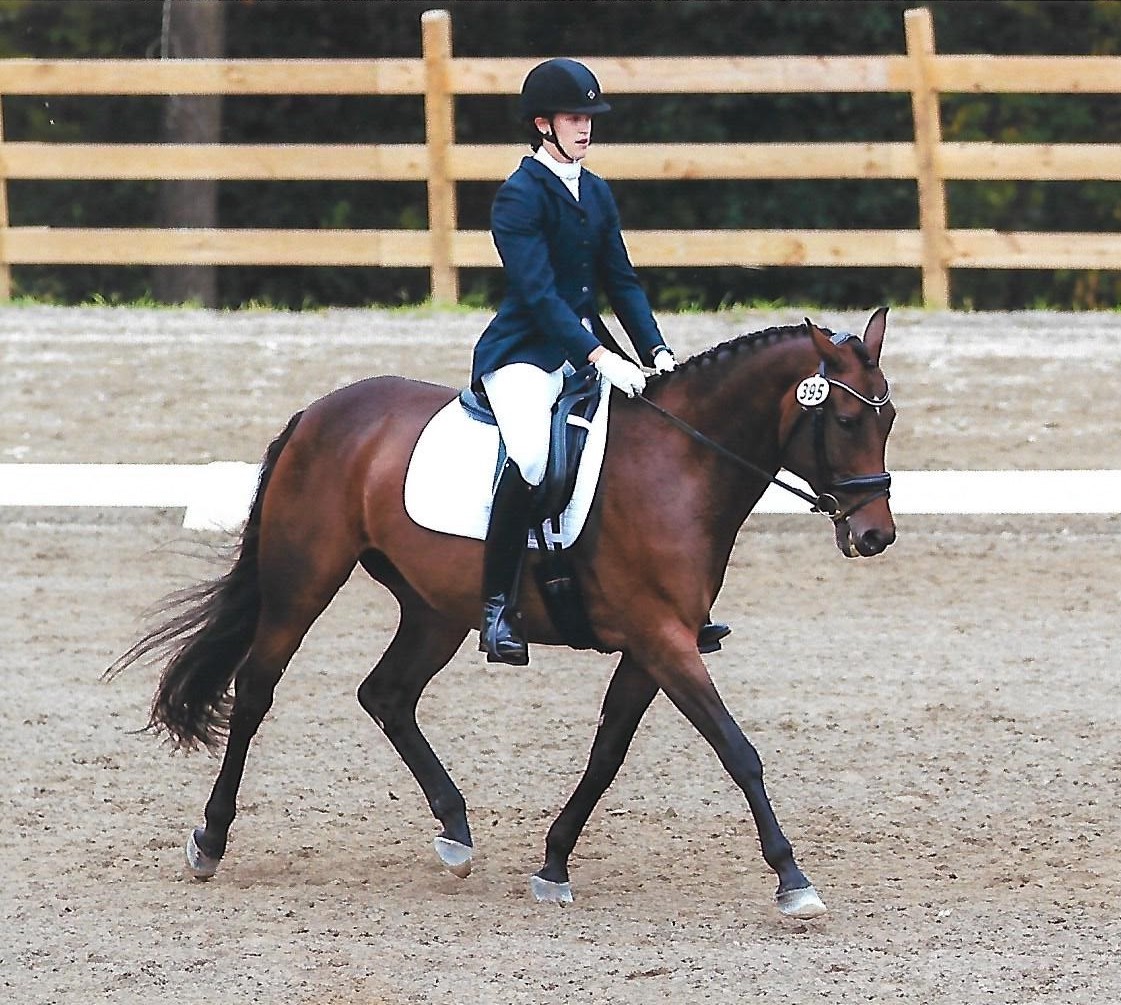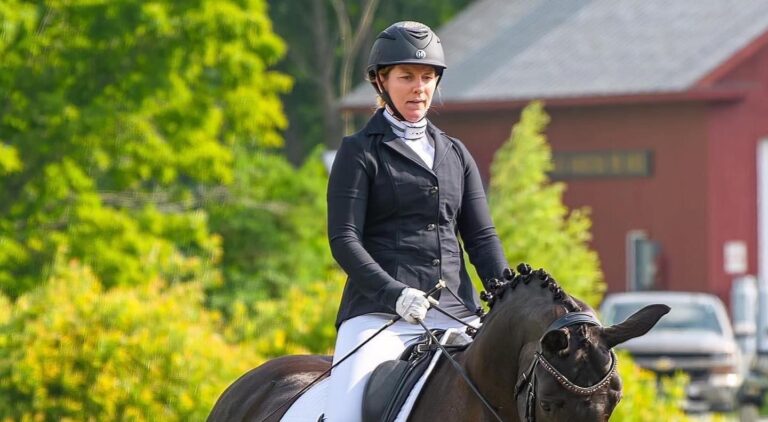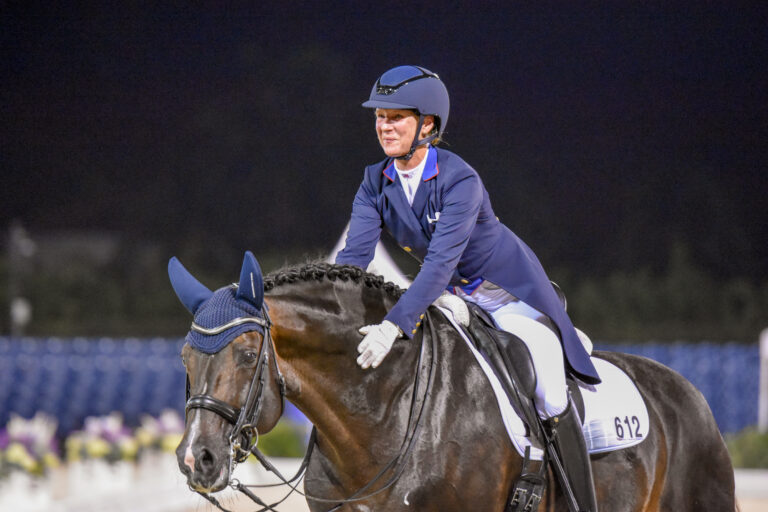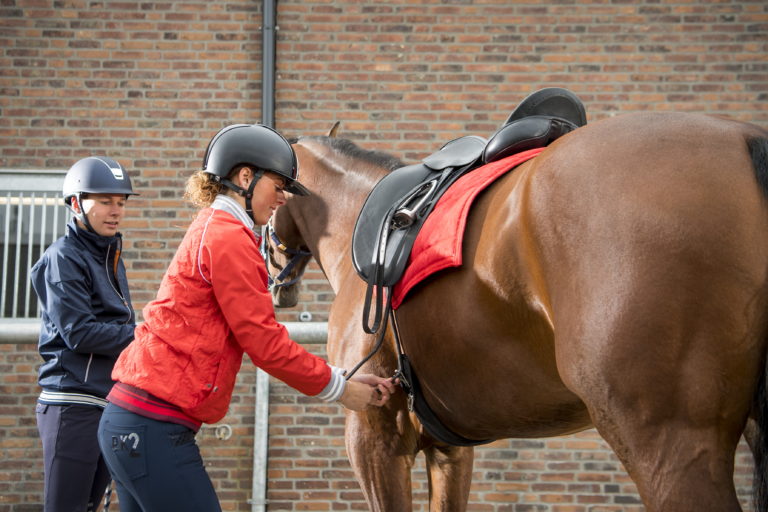This picture shows Alyssa Giulianelli riding her 15-year-old Oldenburg mare, Ramere. They are competing at Second Level.
As I look at the picture, I notice a very high level of concentration between Alyssa and her mare. It appears that they are both fully focused and they trust each other in this situation.
In the moment that this photo was taken, it looks as though Alyssa is starting to lengthen her horse’s stride across the diagonal. Ramere’s hind end looks active, and I particularly like the expression on her face. Her eyes are relaxed, and her mouth is closed, showing some white foam. The way her ears are positioned to the side suggest that she is listening to her rider.

The angle of this picture does not allow me to analyze the horse from a full side view, but I can say that even though the outline is “correct” by the book—Ramere’s ears are the highest point and her nose is in front of the vertical—I would like her to be a little more round in her frame.
To me, Ramere looks like she is sticking her nose a bit forward and not truly carrying herself from her topline. The muscling of her neck hints that it is easy for her to get tight in her jaws and neck. Because of this, it is hugely important to ride with her nose slightly in front of the vertical to avoid tension in the neck and throat. But, on the other hand, this can easily result in the horse leaning forward without proper self-carriage in her shoulders. To improve this picture, I would like for Ramere to have a little more lift in the shoulders to be able to stretch her neck more through her topline and, by that, become rounder in her poll without shortening her frame.
Looking at Alyssa, my first impression is one of softness. There doesn’t seem to be any tension in her seat, she is sitting upright, her legs appear to be simply “hanging” from her hips and I don’t see any squeezing with her knee or lower leg to get the horse to move. Softness is key to allow the horse to move in his or her own natural balance.
Second Level marks the beginning of collected work. For this, Alyssa now needs to learn how to build up more positive tension in her whole body while maintaining the same degree of softness. Suppleness is necessary for horse and rider even in the highest level of performance, but it is not easy to build up positive tension without becoming stiff. However, once you have an understanding of the power of positive tension, you will see that it is a magic tool that can enhance the horse’s ability to carry the rider and expand the quality of movement.
The easiest way to differentiate between positive and negative tension in a rider is to look at the length of her body. Simply put, negative tension will result in shortening, while positive tension will result in lengthening. For example, if Alyssa would pull her knee and heel up, her leg position would shorten and apply negative tension to her horse. Positive tension would result in her leg lengthening from her hip, her knee pushing slightly more down and her ankle lowering. This positive tension allows for suppleness through her whole leg. This is the key to a long, effective and supple leg position.
This positive tension needs to start inside the rider’s body. To learn this feeling, try this: Sit very relaxed, sinking down in the saddle and rounding slightly in your spine with your head still aligned above your pelvis. From that very relaxed, low-tension position, start gradually growing taller until you are at your tallest possible position. As you do this, imagine that the tension in your body is increasing like a scale with eight levels, like an octave in music. Then, gradually shrink back to your lowest and most relaxed position. Next, find your “comfort” position—this varies from person to person, but it should be more toward the middle of the two extremes. In either extreme position—the very slouchy and relaxed position or the stiff and upright position—elasticity and balance are not possible.
If Alyssa feels comfortable toward the middle of the spectrum, maybe around the number four on a scale from one to eight, she should attempt to grow to the five or six range to influence the horse in half-halts and transitions. This will allow her to learn to collect the horse while staying balanced and elastic in her seat.
In addition, there is something tiny but important that I notice in Alyssa’s position: Her hands are slightly facing down with open fingers. While this might look soft, it makes it more difficult to give more freedom to the horse as the only change in position can be closing the fingers—which has the opposite effect.
The rider’s hands should hold the reins in such a way that giving—slightly opening the fingers—can be possible at any time. Alyssa would have to close her fingers before she is able to release again, and this will cause a delay in her timing. The late Sally Swift, founder of Centered Riding®, mentioned the beautiful image that you should hold the reins like you hold a small bird in your hands, not letting it fly away, but not harming it. This describes the supple control that a rider should have in her hands in a wonderful way.
To address hands that face downward, consider this: Our muscles always work in chains and the movement follows these chains like dominos. Try this quick unmounted exercise: Position your upper body and arms as though you are sitting in the saddle. Next, rotate your hands and thumbs in an outward direction (away from each other). As you continue that movement of turning your arms out, feel how the turning out of the upper arms takes your shoulders back and triggers your body to stretch upright. Now, do the opposite: Rotate your wrists inward (fingers facing down) and follow the inward rotation with your arms and shoulders. You will feel how your whole body wants to curl and round. Riding with upright, carried hands helps your body maintain an upright posture. Simply letting your hands drop, facing down, makes it harder for your abdominal muscles to stabilize your upper-body posture.
If I were to give Alyssa a lesson, I would probably give her a short stick (I use a little bamboo stick, but a short whip does the same) to carry on top of her hands, under her thumbs. This will help her keep her wrists upright and will allow some more stability in her upper body.
Figuring out how to play with more positive tension will give Alyssa an important tool to learn to ride in collection while maintaining the suppleness and harmony between her and Ramere.
About Susanne von Dietze
Susanne von Dietze is a leader in equestrian biomechanics. A physiotherapist, licensed Trainer A instructor and judge for dressage and show jumping, she gives lectures and seminars throughout the world, including at the prestigious German Riding Academy in Warendorf. She is a native of Germany and now lives with her husband and three children in Israel, where she competes at the international level. She is the author of two books on the biomechanics of riding: Balance in Movement and Rider and Horse, Back to Back.
This article originally appeared in the Winter 2020 issue.











